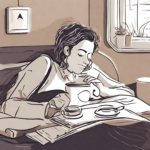Harnessing visualization and imagery for relaxation has become an essential skill for mental and physical well-being. These powerful mental techniques can transport us to a state of tranquility and peace, providing a respite from the chaos of everyday life. This article delves into the effective use of these practices, exploring their benefits and the science behind them, and offers guidance on integrating them into your relaxation routine.
Understanding Visualization and Imagery as Relaxation Tools
Visualization and imagery are cognitive techniques that involve creating soothing mental images or scenarios. A key component in harnessing visualization and imagery for relaxation is understanding that while these practices are often used interchangeably, visualization specifically refers to seeing an image in the mind’s eye, whereas imagery encompasses a broader multi-sensory experience.
The Science Behind Effective Relaxation Techniques
The effectiveness of visualization and imagery as tools for relaxation is backed by science. Studies show that when we engage in these practices, the brain activates similar areas as it does during actual experiences. This neural activation suggests a physical response to mental imagery, which is fundamental in harnessing visualization and imagery for relaxation.
Benefits of Visualization and Imagery in Stress Management
Stress Reduction
Engaging in mental imagery can shift your focus from stress-inducing thoughts to calming scenarios, effectively reducing stress levels. This shift is a vital aspect of utilizing visualization and imagery for relaxation.
Improved Mood
By visualizing positive and uplifting images, you can improve your mood, creating a sense of contentment that is crucial in harnessing visualization and imagery for relaxation.
Enhanced Sleep Quality
Using visualization techniques at bedtime prepares the mind for sleep, improving its quality. This is an essential benefit of harnessing visualization and imagery for better rest.
Better Pain Management
Clinical use of imagery for pain management shows its potential to divert attention from pain to more pleasant thoughts, a significant advantage in harnessing visualization and imagery for relaxation.
Increased Relaxation
Both visualization and imagery encourage a state of deep relaxation by activating the body’s parasympathetic response, vital in harnessing these techniques for stress relief.
How to Practice Visualization and Imagery
1. Find a Quiet Space
Choosing a peaceful environment is critical in harnessing visualization and imagery for relaxation. Ensure the space is comfortable and free from disturbances.
2. Adopt a Comfortable Position
Whether sitting or lying down, comfort is key. Use cushions or blankets to enhance relaxation, an essential aspect of harnessing visualization and imagery for relaxation.
3. Start with Deep Breathing
Begin with deep breathing exercises to center your mind and body, laying the groundwork for effective visualization and imagery.
4. Close Your Eyes and Begin to Visualize
Close your eyes and start visualizing a serene scene. Engage all your senses to make the experience vivid, enhancing the immersive aspect of harnessing visualization and imagery for relaxation.
5. Engage All Your Senses
If external thoughts intrude, gently redirect your focus back to your visualization, a critical skill in mastering imagery for relaxation.
6. Let Go of External Thoughts
After spending time in your mental oasis, gradually bring your awareness back, savoring the calmness you’ve achieved through harnessing visualization and imagery for relaxation.
7. Gradually Return to Reality
After spending 10-20 minutes in your mental oasis, slowly bring your awareness back to the present. Open your eyes, stretch your limbs, and take a moment to appreciate the tranquility you’ve cultivated.
Tips for Enhancing Your Visualization and Imagery Practice
Achieving mastery in harnessing visualization and imagery for relaxation involves personalized and strategic practices:
Consistency is Key
Regular practice enhances the effectiveness of these techniques. Integrating visualization and imagery into your daily routine is pivotal for optimizing relaxation and stress management.
Personalize Your Imagery
Tailoring scenarios that resonate with you personally deepens the connection and effectiveness, a crucial step in harnessing visualization and imagery for relaxation.
Use Guided Imagery Resources
For beginners, guided sessions can provide structure, making the process more accessible and helping in mastering visualization and imagery techniques.
Pair with Relaxing Music
Soft, ambient music can set a serene tone, aiding in the focus and depth of the practice, enhancing the overall experience of visualization and imagery for relaxation.
Keep a Journal
Documenting your experiences and favorite imagery can create a repository of relaxing scenarios, valuable for harnessing visualization and imagery in stress reduction.
Conclusion: Harnessing Visualization and Imagery for Relaxation
Visualization and imagery are powerful, versatile techniques that tap into the mind’s ability to induce calm and tranquility. Regularly engaging in these practices can effectively manage stress, elevate mood, enhance sleep, and foster an overall sense of well-being. Whether you are new to relaxation techniques or an experienced practitioner, incorporating visualization and imagery into your routine can be transformative. Harnessing visualization and imagery for relaxation unlocks new levels of inner peace and contentment, essential in today’s fast-paced world.


